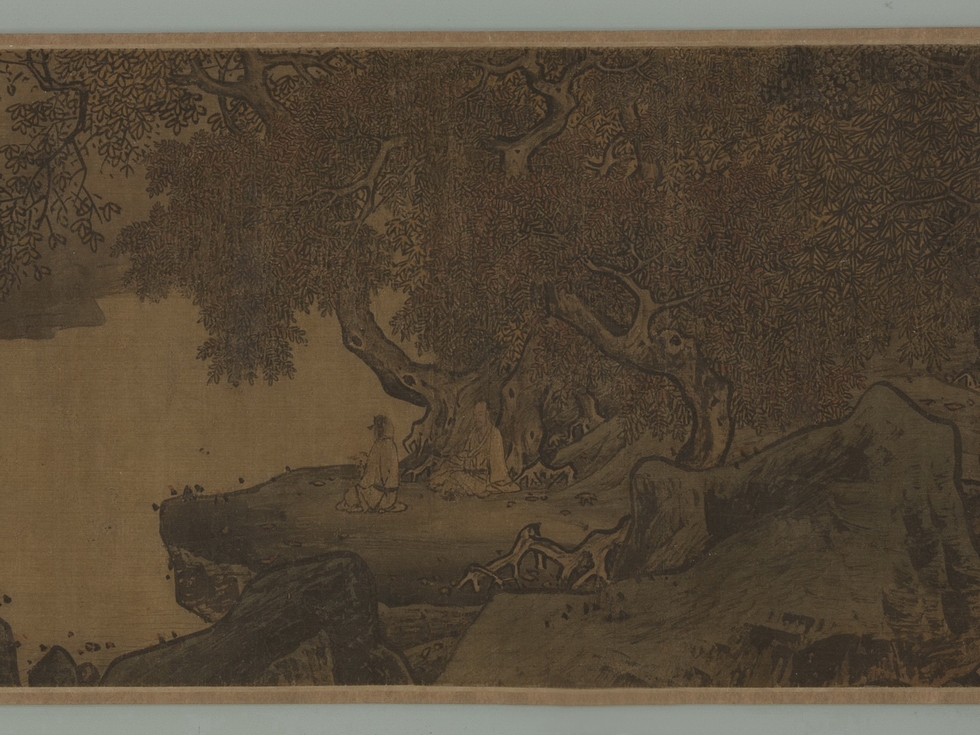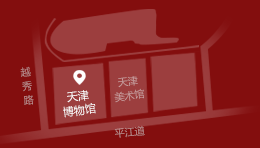宋 李唐 濠梁秋水图卷
宋(960—1279)
绢本 设色
纵24厘米 横114.5厘米
庄子曰:“儵(shū)鱼出游从容,是鱼之乐也。”惠子曰:“子非鱼,安知鱼之乐?”庄子曰:“子非我,安知我不知鱼之乐?”惠子曰:“我非子,固不知子矣;子固非鱼也,子之不知鱼之乐,全矣。”庄子曰:“请循其本。子曰‘汝安知鱼乐’云者,既已知吾知之而问我。我知之濠上也。”
这是《庄子?秋水篇》中庄子与惠子在濠梁之上的一场著名论辩,它虽简单却反映出二人不同的世界观与认识论。天津博物馆藏李唐《濠梁秋水图》卷(又名《濠濮图》卷)即描绘了此番场景。
李唐(约1049-1170),字晞古,河阳三城(今河南省孟县)人。李唐作画题材丰富,所绘山水、人物、花鸟画皆精妙,亦善画牛,是两宋之交最为杰出的画家之一。其山水画初学李思训,变荆浩、范宽之法,创立了“水墨苍劲”的大斧劈皴山水画,成为山水画史上开宗立派的一代宗师。他与刘松年、马远、夏圭并称为“南宋四家”。
天津博物馆藏《濠梁秋水图》卷,是李唐传世作品中的精品。绢本,设色,纵24厘米,横114.5厘米。全卷以山水为主,淡泊疏野,山泉迎面飞泻,溪中零星矶石,曲波流水环绕而下,画卷右侧巨石突兀、秋林繁茂,作者以稳健豪迈的笔调描绘了安徽凤阳濠水、濮水一带清新幽静的风光,也描绘了溪流丛林间二位先贤庄子与惠子坐而论道的场景。
Autumn Waters at Haoliang
Li Tang(c. 1049-1130)
Song dynasty(960-1279)
Hand scroll, ink and colour on silk
Height 24cm, Width 114.5cm
This hand scroll depicts a scene by the confluence of the Hao and Pu rivers in Fengyang County, Anhui Province. In the painting, two worthies sit by the riverside discussing the Dao.. The subject of this painting is derived from the “autumn waters” section of the Zhuangzi. There is no inscription on the painting, and the attribution to Li Tang is based on a Ming dynasty colophon by Fan Yunlin at the end of the scroll. The movements of the brush are vigorous yet exact, the tip making neat cut-like strokes in a dark ink tone imbuing the piece with an animated mood. The figures are meticulously detailed with their garments succinctly rendered, in the archetypal style of Li Tang’s paintings.
Li Tang had the style name Xi Gu and was a native of Sancheng in Heyang (modern day Meng County in Henan Province). He made certain adaptations to the orthodox landscape methods of Jing Hao, Guan Tong and Fan Kuan. He used vigorous brushwork to apply dark-toned ink densely, evoking a sense of elegant majesty and initiating the new landscape style of the Southern Song. Along with Liu Songnian, Ma Yuan and Xia Gui, Li Tang created the institutional style of the Southern Song. Together they are known as the Four Masters of the Southern Song.







 电话:022-83883000
电话:022-83883000 传真:022-83883088
传真:022-83883088 地址:天津市河西区平江道62号
地址:天津市河西区平江道62号